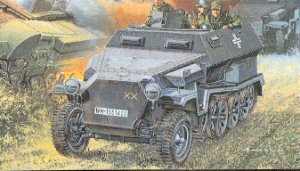
DML 1/35 Sd.Kfz.251/1 Ausf.C Rivetted Version Kit First Look
By Cookie Sewell
| Date of Review | August 2004 | Manufacturer | DML |
|---|---|---|---|
| Subject | Sd.Kfz.251/1 Ausf.C Rivetted Version | Scale | 1/35 |
| Kit Number | 6246 | Primary Media | 511 parts (449 in grey styrene, 54 in etched brass, 8 in vinyl |
| Pros | What the 30-year-old Tamiya kit SHOULD have looked like; very nice set of options to make a showpiece out of the box | Cons | Vinyl driver figure may not be popular with painters; fine brass parts may be beyond desire of some modelers to use; small two-piece track links get mixed comments from many modelers |
| Skill Level | Basic | MSRP (USD) | $34-37 |
First Look
The Ausf. C variant of the well-known German 3-ton halftrack family (mittlere Schuetzenpanzerwagen) entered production in 1940 and became the first true mass -production version of the vehicle, being produced by six different factories - Hanomag (the designer), MNH, Schichau, Wumag, Weserhuette, and Borgward. Both riveted hull and welded hull versions were produced until late 1943, when the ballistically superior (and simpler) all-welded Ausf. D went into production. While less common than the welded variant, it was nevertheless a standardized vehicle.
When the Tamiya Sd.Kfz. 251/1 Ausf. C halftrack kit came out in late 1973, many modelers rejoiced that a decent kit of this vehicle - complete with a nice new set of dismount figures - was going to finally be available. And for the time, had there been any interest in it, the 251 would have gone head on head with the famous Tamiya "88" kit for Kit of the Year honors.
But the bloom wore off the rose pretty fast. First off, it did not take too long before most serious modelers suddenly realized this kit was nearly a scale foot too narrow. Second, all of the big tall strapping German infantry scaled out at between 5'2" and 5'4", not very strapping; they also turned out to be quite stocky. Also, as research continued, it turned out to have been based on several prototypes, most notably the rusted-out C hulk at APG, which were not standard vehicles.
DML have now released their version of that vehicle, the C model with the early riveted hull, and it is quite a difference. It is essentially the earlier welded hull kit with some minor differences - a new H sprue of the major riveted components of the hull, a new MA brass fret that includes hinges for the view ports in the interior, and the German Panzerjaegers - Eastern Front 1944 (#6058) figure set included as well.
The kit therefore has a wealth of details and comes with everything but the engine for the drive line. This version apparently uses the wooden seats, so those are the ones shown in the directions. There are supplemental instructions for the view port details, so I recommend that if you do want to use the brass parts you stop at step 9 and carry out the work prior to assemblying the hull. (The supplemental directions only tell you how to assemble the brass, but not which step to do that in.) If you're REALLY REALLY good you can probably even get them to work!
The vinyl driver figure may elicit some groans when modelers see him. However, according to DML this is now made from the newer "glueable" vinyl that can be assembled with normal model cements. The reason he cites is that this is the only way to make it easier to get the figures painted AFTER the model is done and then installed in their normal places; hard plastic figures do not flex and therefore would have to normally be installed prior to cementing the hull halves together. Since the directions no longer call out for ACC cement, I assume this to be the case. Also, there are two extra jackets and a pair of shoes made from vinyl as well.
The two-part single link tracks are not popular with some modelers, but I have talked to others that call this particular set a snap. If you use a thicker gel-type plastic cement like Vollmer Superzement S-30 or Tamiya Orange Cap they can be made to operate as well as assemble fairly quickly.
Only one finishing option is included - for a vehicle from the 6th Panzer Division in Russia - but decals are provided from a new master sheet and the license plate set seen in the previous kit, so any sort of option is possible if you have a photo reference to use.
Overall, this is another very nice effort and a good deal for the money.
Thanks to DML for the review sample.







